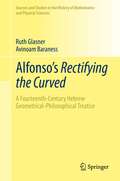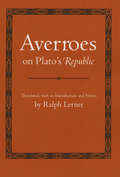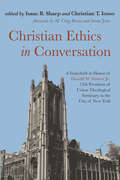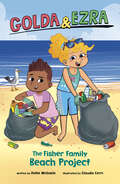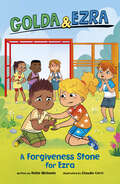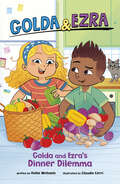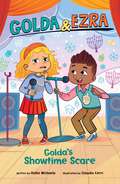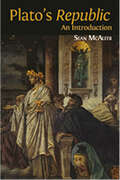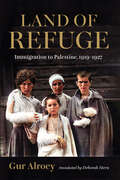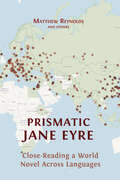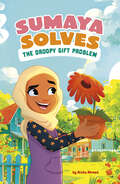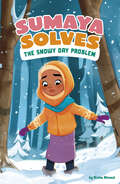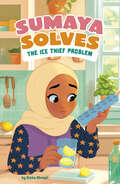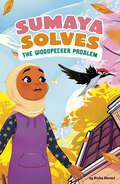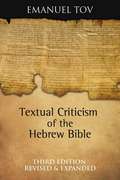- Table View
- List View
Alfonso's Rectifying the Curved: A Fourteenth-Century Hebrew Geometrical-Philosophical Treatise (Sources and Studies in the History of Mathematics and Physical Sciences)
by Ruth Glasner Avinoam BaranessThis volume offers a new English translation, introduction, and detailed commentary on Sefer Meyasher 'Aqov, (The Rectifying of the Curved), a 14th-century Hebrew treatise on the foundation of geometry. The book is a mixture of two genres: philosophical discussion and formal, Euclidean-type geometrical writing. A central issue is the use of motion and superposition in geometry, which is analyzed in depth through dialog with earlier Arab mathematicians. The author, Alfonso, was identified by Gita Gluskina (the editor of the 1983 Russian edition) as Alfonso of Valladolid, the converted Jew Abner of Burgos. Alfonso lived in Castile, rather far from the leading cultural centers of his time, but nonetheless at the crossroad of three cultures. He was raised in the Jewish tradition and like many Sephardic Jewish intellectuals was versed in Greek-Arabic philosophy and science. He also had connections with some Christian nobles and towards the end of his life converted to Christianity. Driven by his ambition to solve the problem of the quadrature of the circle, as well as other open geometrical problems, Alfonso acquired surprisingly wide knowledge and became familiar with several episodes in Greek and Arabic geometry that historians usually consider not to have been known in the West in the fourteenth century. Sefer Meyasher 'Aqov reflects his wide and deep erudition in mathematics and philosophy, and provides new evidence on cultural transmission around the Mediterranean.
Averroes on Plato's "Republic"
by Averroes Ralph Lerner"In one fashion or another, the question with which this introduction begins is a question for every serious reader of Plato's Republic: Of what use is this philosophy to me? Averroes clearly finds that the Republic speaks to his own time and to his own situation. . . . Perhaps the greatest use he makes of the Republic is to understand better the shari'a itself. . . . It is fair to say that in deciding to paraphrase the Republic, Averroes is asserting that his world--the world defined and governed by the Koran--can profit from Plato's instruction."--from Ralph Lerner's IntroductionAn indispensable primary source in medieval political philosophy is presented here in a fully annotated translation of the celebrated discussion of the Republic by the twelfth-century Andalusian Muslim philosopher, Abu'l-Walid Muhammad Ibn Ahmad Ibn Rushd, also know by his his Latinized name, Averroes. This work played a major role in both the transmission and the adaptation of the Platonic tradition in the West. In a closely argued critical introduction, Ralph Lerner addresses several of the most important problems raised by the work.
Christian Ethics in Conversation
by Isaac B. Sharp Christian T. IossoInspired by Donald W. Shriver Jr.'s leadership of Union Theological Seminary (New York City), Christian Ethics in Conversation brings together essays by members of a stellar faculty--including Gary Dorrien, Larry Rasmussen, Phyllis Trible, and Cornel West--and interdisciplinary colleagues, such as Columbia University biologist Robert Pollack, Chancellor Emeritus of the Jewish Theological Seminary Ismar Schorsch, and Pulitzer Prize-winning Yale historian David W. Blight. The challenges they describe of embracing diversity while facing financial pressure and encouraging social change speak to seminaries, churches, denominations, and faithful individuals facing similar challenges today. The chapters model the kinds of interdisciplinary, interfaith, and inter-institutional conversations foundational to Shriver's approach to Christian public ethics. Shriver and Union Seminary addressed racial justice directly, and colleagues describe lessons learned from an activist-academic who was also a Southerner committed to reconciling and repairing the wounds of history. International conversation partners analyze the place of moral claims in successful social transformation, but those claims also had to be lived out in the seminary's institutional life. Gender justice, full inclusion, and liberation theologies became crucial to Union's identity, but not automatically. The changes required are described by a former dean, board member, worship leader, and several students. All the while, faculty and students of Union and its neighbors were engaged in ongoing debates about honest patriotism, friendship across division, and the dangers of uncritical nationalism, also captured by the book's contributors. With contributions from: M. Craig Barnes Serene Jones Dean K. Thompson Donald W. Shriver, Jr. Gary Dorrien Milton McCormick Gatch, Jr. Larry Rasmussen Cornel West: Janet R. Walton James A. Forbes, Jr. Phyllis Trible Robert Pollack Ismar Schorsch Hays Rockwell Thomas S. Johnson Lionel Shriver David Kwang-sun SUH Roger Sharpe Bill Crawford Robert W. Snyder Eric Mount Joseph V. Montville Helmut Reihlen and Erika Reihlen David Blight Ronald H. Stone Steve Phelps
Divine Style: Walt Whitman and the King James Bible
by F. W. Dobbs-AllsoppIn exploring the seminal works of Walt Whitman, the great American poet, many commentators have acknowledged the underlying influence of The King James Bible. However, a study has yet to elucidate the precise manner in which the Bible has shaped Whitman’s poetic style. This is the deficit that F. W. Dobbs-Allsopp seeks to address in his new piece of literary scholarship: 'Divine Style: Walt Whitman and the King James Bible'. Dobbs-Allsopp, Professor of Old Testament at Princeton Theological Seminary, explicitly approaches Whitman from the perspective of a biblical scholar. Utilising his wealth of expertise in this field, he constructs a compelling, erudite and methodical argument for the King James Bible’s importance in the evolution of Whitman’s style – from his signature long lines to the prevalence of parallelism and tendency towards parataxis in his works. 'Divine Style' focuses on Whitman’s output in the years preceding the release of his 1855 opus 'Leaves of Grass' through the general period of the book’s first three editions. In this, Dobbs-Allsopp’s exploration of the period is exhaustive – covering not just Leaves of Grass but recently recovered notebooks, newly digitised manuscripts and additions to the corpus, such as the novel 'Life and Adventures of Jack Engle'. This is a work of careful, detailed scholarship, offering an authoritative commentary that will be a valuable resource for students of Whitman, biblical scholars and scholars of literature more generally.
The Fisher Family Beach Project
by Hollie MichaelsIt's beach day! And Golda and Ezra are looking forward to having a sandcastle-building competition with their friends. But when Ezra, Golda, and their parents arrive at the beach, things aren't pretty—there's trash everywhere. Can Golda, Ezra, their parents, and their friends save their beach day?
A Forgiveness Stone for Ezra
by Hollie MichaelsOne day at school, Golda sees Ezra slip from the monkey bars in front of his classmates. He hurts his wrist. But—mostly—he's embarrassed and doesn't want to go back to school. So Golda gets to work, of course! Can Golda and Ezra's classmates help him feel better about returning to school after a terrible tumble?
Golda and Ezra's Dinner Dilemma
by Hollie MichaelsWhen Golda and Ezra visit their neighbor Ms. Ortega to return a dish, they learn that Ms. Ortega has to go out of town unexpectedly. But she was supposed to cook a big meal for the senior center using the harvest from her garden—like she does every Sunday. That's a problem Golda is certain they can solve! Can Golda and Ezra figure out how to make sure the seniors at the senior center get their special dinner anyway?
Golda's Showtime Scare
by Hollie MichaelsGolda and Ezra are helping out with the winter show at their community center. Golda's helping with the set. And Ezra's helping run the show—naturally. But when the kids who were supposed to perform the dreidel song get sick, Golda and Ezra step in. Just one problem: Golda's not so good at performing on stage. Can Ezra help his sister get over her stage fright and wow the community with their performance?
Horos: Ancient Boundaries and the Ecology of Stone
by Thea PotterIn Horos, Thea Potter explores the complex relationship between classical philosophy and the ‘horos’, a stone that Athenians erected to mark the boundaries of their marketplace, their gravestones, their roads and their private property.
Jesus and the Making of the Modern Mind, 1380–1520
by Luke ClosseyFor his fifteenth-century followers, Jesus was everywhere – from baptism to bloodcults to bowling. This sweeping and unconventional investigation looks at Jesus across one hundred forty years of social, cultural, and intellectual history. Mystics married him, Renaissance artists painted him in three dimensions, Muslim poets praised his life-giving breath, and Christopher (“Christ-bearing”) Columbus brought the symbol of his cross to the Americas. Beyond the European periphery, this global study follows Jesus across – and sometimes between – religious boundaries, from Greenland to Kongo to China. Amidst this diversity, Jesus and the Making of the Modern Mind, 1380-1520 offers readers sympathetic and immersive insight into the religious realities of its subjects. To this end, this book identifies two perspectives: one uncovers hidden meanings and unexpected connections, while the other restricts Jesus to the space and time of human history. Minds that believed in Jesus, and those that opposed him, made use of both perspectives to make sense of their worlds. This book includes over one hundred images, tables and audio clips.
Land of Refuge: Immigration to Palestine, 1919–1927 (Perspectives on Israel Studies)
by Gur AlroeyAfter the First World War, tens of thousands of Jews immigrated to Palestine. They went there not to found a Zionist state but primarily to seek refuge from the violence and persecution of the Russian Civil War and its aftermath. Fleeing to the United States was not an option due to heavily restrictive immigration laws enacted there in the early 1920s.In Land of Refuge , the experiences of this generation of Jewish immigrants come vividly to life through a wealth of previously unstudied archival sources. Historian Gur Alroey skillfully weaves together the riveting and remarkable stories of survivors of pogroms and riots in Ukraine and Uramia, including widows, orphans, and survivors of rape and other unimaginable violence; migrants who risked harrowing journeys by boat, only to endure illness on the way, be detained or sent back, or have their luggage broken into or stolen; survivors of the famine in Russia during the Lenin and Stalin regimes; and marginalized Jews such as the mentally ill, thieves, prostitutes, and those with falsified entry visas. The stories of the people at the core of Land of Refuge form an important but little appreciated part of the history of the Jewish settlement in the Land of Israel.
Prismatic Jane Eyre: Close-Reading a World Novel Across Languages
by Matthew Reynolds OthersJane Eyre, written by Charlotte Brontë and first published in 1847, has been translated more than five hundred times into over sixty languages. Prismatic Jane Eyre argues that we should see these many re-writings, not as simple replications of the novel, but as a release of its multiple interpretative possibilities: in other words, as a prism. Prismatic Jane Eyre develops the theoretical ramifications of this idea, and reads Brontë’s novel in the light of them: together, the English text and the many translations form one vast entity, a multilingual world-work, spanning many times and places, from Cuba in 1850 to 21st-century China; from Calcutta to Bologna, Argentina to Iran. Co-written by many scholars, Prismatic Jane Eyre traces the receptions of the novel across cultures, showing why, when and where it has been translated (and no less significantly, not translated – as in Swahili), and exploring its global publishing history with digital maps and carousels of cover images. Above all, the co-authors read the translations and the English text closely, and together, showing in detail how the novel’s feminist power, its political complexities and its romantic appeal play out differently in different contexts and in the varied styles and idioms of individual translators. Tracking key words such as ‘passion’ and ‘plain’ across many languages via interactive visualisations and comparative analysis, Prismatic Jane Eyre opens a wholly new perspective on Brontë’s novel, and provides a model for the collaborative close-reading of world literature. Prismatic Jane Eyre is a major intervention in translation and reception studies and world and comparative literature. It will also interest scholars of English literature, and readers of the Brontës.
Studies in Rabbinic Hebrew
by Shai HeijmansThis volume presents a collection of articles centring on the language of the Mishnah and the Talmud – the most important Jewish texts (after the Bible), which were compiled in Palestine and Babylonia in the latter centuries of Late Antiquity. Despite the fact that Rabbinic Hebrew has been the subject of growing academic interest across the past century, very little scholarship has been written on it in English. Studies in Rabbinic Hebrew addresses this lacuna, with eight lucid but technically rigorous articles written in English by a range of experienced scholars, focusing on various aspects of Rabbinic Hebrew: its phonology, morphology, syntax, pragmatics and lexicon. This volume is essential reading for students and scholars of Rabbinic studies alike, and constitutes the first in a new series, Studies in Semitic Languages and Cultures, in collaboration with the Faculty of Asian and Middle Eastern Studies at the University of Cambridge.
Sumaya Solves the Droopy Gift Problem
by Aisha AhmedSumaya's cousin is graduating from high school, and Sumaya wants to give her a flowering plant as a gift. But the plant begins to droop before graduation day. Can Sumaya solve her droopy plant problem before it's too late?
Sumaya Solves the Ice Thief Problem
by Aisha AhmedAfter a fresh snowstorm, Sumaya is excited to play in the snow, but before long, she's freezing cold and needs to head inside. She starts to wonder, how do polar animals live outside in the cold? Can learning more about polar animals help her stay warm outside even on a cold day?
Sumaya Solves the Ice Thief Problem
by Aisha AhmedOn a hot summer day, Sumaya is all set to make some lemonade. But before she is able to fix her refreshment, the ice goes missing. Where did it go? Is there an ice thief in the house?
Sumaya Solves the Ice Thief Problem
by Aisha AhmedWhen Sumaya discovers a busy woodpecker in her backyard, she worries the bird could be hurting its head and neck. She sets out to create some inventions to help protect the bird. How will Sumaya solve the woodpecker problem?
Textual Criticism of the Hebrew Bible, Third Edition, Revised and Expanded
by Emanuel TovSince its initial publication, Textual Criticism of the Hebrew Bible has established itself as the indispensable authoritative textbook and reference on the subject. In this thoroughly revised third edition, Emanuel Tov has incorporated the insights of the last ten years of scholarship, including new perspectives on the biblical texts among the Dead Sea Scrolls, all of which have now been published. Here are expanded discussions of the contribution of textual criticism to biblical exegesis and of the role of scribes in the transmission of the text. The introduction and references throughout the book have been thoroughly revised with the beginning student of textual criticism in mind.
This Generation Leads: The Latest Leadership Ideas From South Africa
by Mike Teke &Muzi KuzwayoThis book was borne out of an idea that I had during the period in which I spent time with several young people who had approached me to assist them in different ways, including personal development, career advancement and growth, as well as growing their businesses and entrepreneurial acumen and skills. I took the challenge but felt that more could be achieved, hence this book. The chapters in this book are written by each one of these young people. They chose the topics, guided by me, and the plan was to simply convey a message from each one of them about leadership. They did not do this for fame or to sell this book to make money, but to share their ideas. The topics covered in this book will appeal to different readers, and some readers might find more lessons in one chapter or in more chapters than one. - Mike Teke
